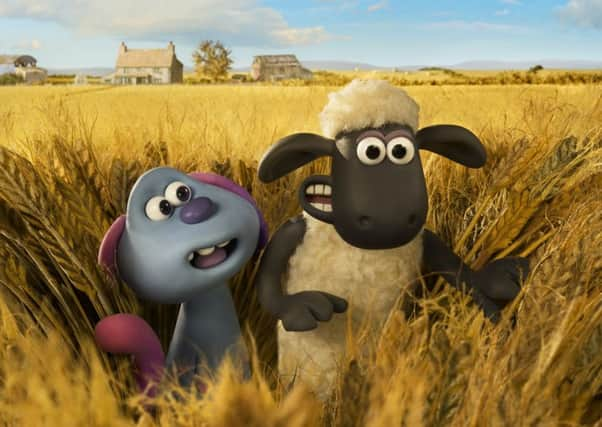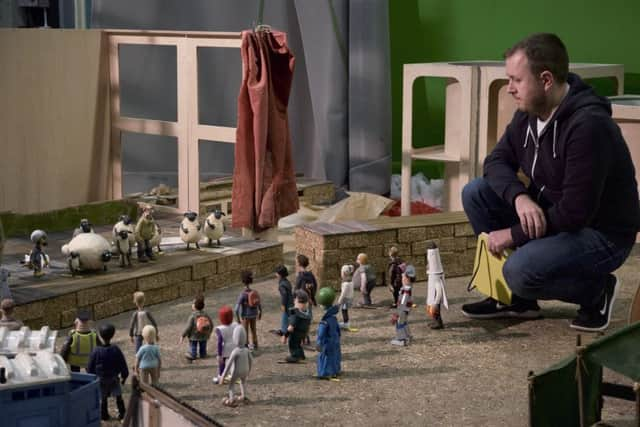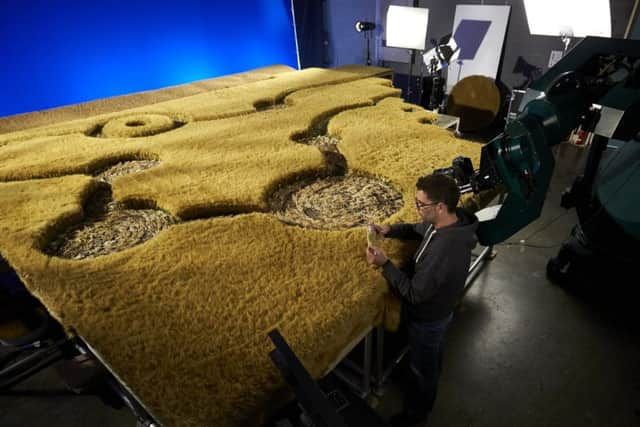Aardman uncovered: Behind the scenes on A Shaun the Sheep Movie: Farmageddon


It’s the first week in March and I’m standing on an elaborate Bond-style set that looks like a tribute to the hollowed-out volcano hideout in You Only Live Twice. “Oh, it’s unashamedly Ken Adams,” says art director Matt Perry, referring to the legendary production designer of some of the most iconic Bond films. “This is the biggest interior set we’ve done on any film.”
As it happens, “biggest” in this case isn’t much of a boast. The set in question is for Aardman Animations’ new film A Shaun the Sheep Movie: Farmageddon and it would be more accurate to say I’m standing next to it rather than on it. Measuring roughly 12 metres by seven, it barely comes up to my waist. It’s being used to shoot what will, in the finished film, be a high-octane chase featuring characters that are just centimetres high and made partly from plasticine.
Advertisement
Hide AdBut if the set represents a relatively small step up in size for the Bristol-based stop-motion animation studio, it represents a giant leap forward in terms of the scale of ambition for what is actually Aardman’s first ever feature-length sequel. When the first film, Shaun the Sheep Movie, came out in 2015 it earned more than $100m at the box office and picked up an Oscar nomination for best animated film, consolidating the character’s status as the company’s most valuable brand. Which isn’t bad going for a naughty sheep who never says a word.


“In movie terms it was quite low-concept,” admits producer Paul Kewley of the first film. “This time we wanted to do something more exciting and bigger and exploit a genre we’ve never done before.”
In short, they wanted something out of this world that would still feel of their world. So they came up with a madcap, very Aardman riff on ET and Close Encounters of the Third Kind: a sci-fi adventure in which Shaun befriends a cute but mischievous alien call Lu-La who has crash-landed in the nearby town of Mossingham.
Crop circles, flying saucer gags, a slew of genre-appropriate movie and TV references (Doctor Who, X-Files, 2001, Robocop) duly follow as Shaun’s owner, the farmer, tries to exploit local UFO fever by turning Mossy Bottom farm into a ramshackle alien theme park. Shaun and Lu-La, meanwhile, have to evade the clutches of the Ministry for Alien Detection (MAD for short), a government body led Agent Red, an officious bureaucrat – her pet robot is a filing cabinet – who is hell-bent on catching an alien and may or may not be inspired by former prime minister Theresa May (Kewley says she is; co-director Will Becher tells me later, “No, she’s not” – then sheepishly admits he’s sticking to the press briefing).
The Bondian set is actually MAD’s underground lair: a secret compound housed beneath a nondescript carwash and populated by hazmat-suited nerds who goof around when the boss isn’t looking. Conceptually, Aardman’s studio isn’t all that different. Located in an anonymous warehouse on an industrial estate on the outskirts of Bristol, the production facility – Aardman has shot all of its films here since Chicken Run in 2000 – has more in common with the drabness of The Office than the Silicon Valley sleekness of Pixar.


As you wait in the canteen, though, the artisanal magic of Aardman’s movies starts seeping through. Display cases featuring props from recent productions line the walls, a note on a door reads “CR2 script meeting. Do Not Disturb” (the studio will release a sequel to Chicken Run next year) and beneath signed drawings from celebrity fans such as The Simpsons creator Matt Groening, a large window overlooks the studio’s vast art department where numerous craftsmen and craftswomen are hunched over desks, working on props and models next to a cabinet containing nothing but drawers full of plasticine mouths (the first Shaun the Sheep film got through 3,000 of these).
Advertisement
Hide AdThe film’s stars aren’t made completely of plasticine though. They’re mostly built from silicone, resin and Newplast modelling clay, the sort you buy for kids in art supply shops but which – as model builder Will Harding explains – is mixed on site on an industrial scale and has chalk added to it to make it more durable under the hot studio lights. Everything is moulded onto a metal skeleton, or armature, to make articulation of the puppets easier. A model like new character Lu-La can take up to six months to design and build (12 have been made for the film; there are 12 Shauns too).
But that’s the nature of handcrafted stop-motion animation: everything takes a long time. Which is why, with only two-weeks left on Farmageddon’s year-long shoot, 26 animators are currently working across some 35 sets, or “units.”
Advertisement
Hide AdOn one of these units, animator Andy Symanowski is working on one of the film’s most complicated sequences: a robot fight between Agent Red and Bitzer the dog on the Farmageddon theme park set. The shot he’s setting up is 64 frames long and will take him three days to complete. It will last fewer than three seconds on screen.
How do directors Richard Phelan and Will Becher keep on top of something so incremental?
“It’s shooting now, but we’ve been in pre-production for several years so we’ve watched it hundreds of times,” says Phelan. “Each sequence you see has probably gone through the story process about 50 times.”
There are no out-takes on Aardman films. Everything is done in one take. The frame Symanowski has just completed will be part of the final film, fingerprints and all. It’s that precise: perfectly imperfect.
But that’s also part of the enduring legacy of studio. “We screen the film internally every week and it’s fantastic to be able to show it to Nick Park and [Aardman co-founder] Peter Lord,” says Phelan.
“It’s amazing to sit in a room with them,” adds Becher. “I mean, it’s nerve-wracking as hell, but to be able to present it to a room full of people who have won Oscars for this sort of thing is amazing.”
Advertisement
Hide AdIndeed, the Oscar that Park won for A Close Shave is sitting behind us, so casually displayed in what amounts to the anonymous office conference room you’d be forgiven for not noticing it.
That film is especially important to Shaun the Sheep. The character made his first appearance in it –though it’s another Wallace and Gromit short, The Wrong Trousers, that really hooked Phelan and Becher when they were younger – so much so they’re paying tribute in their film with the aforementioned chase sequence in MAD’s underground layer.
Advertisement
Hide Ad“So many people who work here worked on it,” beams Phelan. “Including the cinematographer who filmed the train chase. He’s working on this one so we can call on his experience.”
“Literally an hour ago I was on set with him and looking at a shot in The Wrong Trousers and he was telling me about a type of shot they invented for it that we use,” marvels Becher. “I didn’t imagine I’d ever be sitting here doing this.” A Shaun the Sheep Movie: Farmageddon is in Scottish cinemas from 13 October and released nationwide on 18 October.